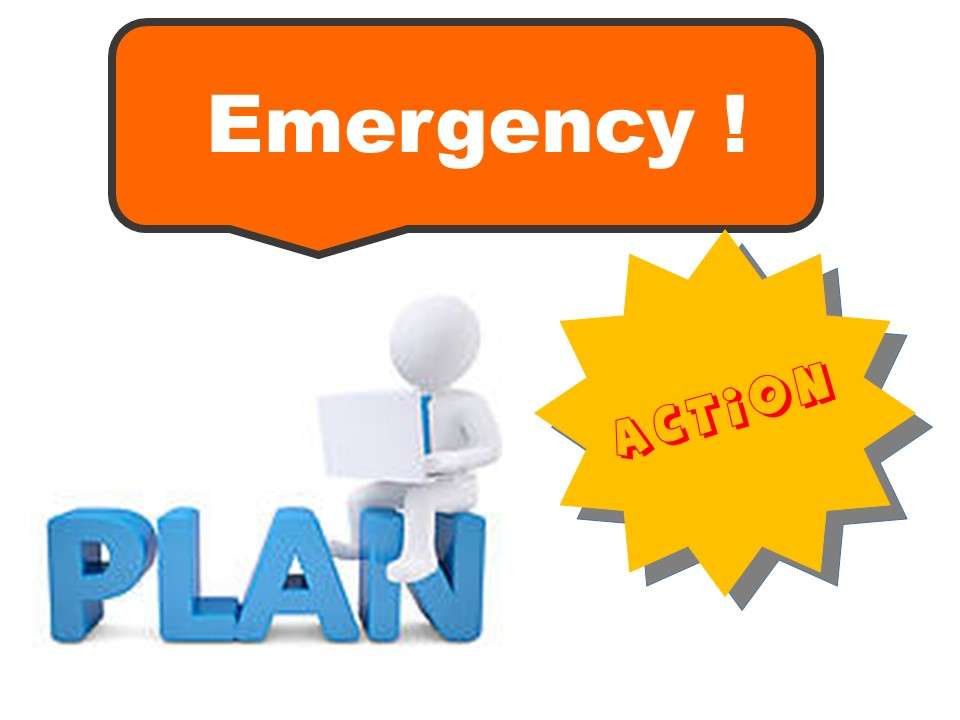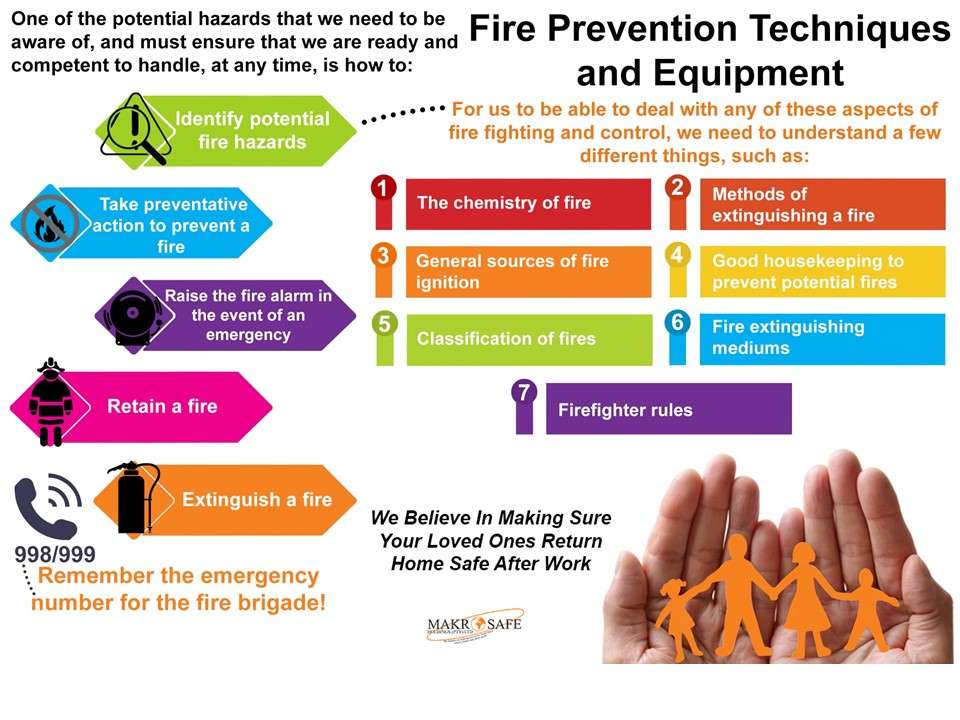What is the purpose of an Emergency Plan?
Emergency Preparedness
A workplace emergency is an unforeseen situation that threatens your employees, customers, or the public, disrupts or shuts down your operations, or cause physical or environmental damage.
Emergencies may be natural or man made and include the following:
> Floods
> Hurricanes
> Tornadoes
> Fires
> Toxic gas releases
> Chemical spills
> Radiological accidents
> Explosions
> Civil disturbances
> Workplace violence resulting in bodily harm and trauma. Emergency Plans
Emergency Plans
Your employer will have plans to deal with all possible emergencies that can occur at your workplace. These plans will have been discussed with you during your induction training and it will also be posted on notice boards. These plans rely on the employees to act in a certain manner during an emergency to ensure that no one else is injured or killed during these situations.
During a fire, every one's safety depends on good preparation and efficient evacuation. The first step is to find out what the emergency telephone numbers are for the area you are working in and to make sure that every Health and Safety Representative and Supervisors has the numbers available.
The numbers should also be given to all the department and section heads and should be displayed in prominent places all over the workplace.
Your plan must include a way to alert employees, including disabled workers, to evacuate or take other action, and how to report emergencies, as required. Among the steps you must take are the following:
Make sure alarms are distinctive and recognised by all employees as a signal to evacuate the work area or perform actions identified in your plan.
Make available an emergency communications system such as a public-address system, portable radio unit, or other means to notify employees of the emergency and to contact local law enforcement, the fire department, and others.
Stipulate that alarms must be able to be heard, seen, or otherwise perceived by everyone in the workplace. You might want to consider providing an auxiliary power supply in the event that electricity is shut off.
What is the purpose of an emergency plan?
The purpose of an Emergency Plan is to document the recovery strategies, essential resources, and procedures necessary to implement a recovery process. It is often referred to as a “disaster plan”. An emergency is any unplanned event that can shut down you business, disrupt operations, cause physical or environmental damage, threaten your businesses’ financial standing or image, or even cause deaths or significant injuries to employees, clients or the public. Emergencies and disasters can strike anytime and anywhere and often when you least expect it.
So where do you begin? How do you protect your employees and your business? Few people can think clearly and logically in a crisis, so the best way is to plan in advance - brainstorm the worst-case scenarios and ask yourself what you would do if the worst happened.
This brainstorming process is best accomplished working with your businesses’ employees during department or group meetings. It serves the dual role of building awareness of emergency planning, as well as surfacing potential risk areas about which management may not have been aware.
The components of an emergency plan include:
- Emergency personnel
- Emergency communication
- Emergency equipment
- Emergency transportation
Effective planning will:
Safeguard your investment and critical resources (human resources/physical resources/business continuity).
Help to determine your business vulnerabilities.
Provide a logical sequence of events and tasks.
Shorten the time to affect a recovery.
Minimise the costs of the recovery.
Avoid confusion and reduce exposure to error in the recovery process.
Avoid duplication of efforts during the recovery process.
It is important to pay attention to emergency escape routes, assembly points and refuge bays in the work area. All staff members or employees should:
> Know the location of all building exits.
> Know the location of the nearest fire alarms and how to use them. Count the doors or desks between their work area and the nearest exit. During a fire, exit signs may not be visible due to smoke or a power failure.
> Sound the alarm and leave the building immediately, closing all doors behind you. If you have been trained as a fire fighter, you must try to extinguish the fire but if it is to big then exit the building and join up with the other fire fighters.
> If smoke blocks your primary exit, use another one. If you must exit through the smoke, stay low by crawling on your hands and knees. Help the injured and lead others to the exits.
> Check doors before opening them. Kneel or crouch at the door, reach up and touch the door knob, and frame. If you feel warmth on or around the door, use another escape route. If the door feels cool, open it slowly and carefully with your shoulder against it. Slam the door shut if you see flames or smoke on the other side.
> Call the local emergency number, no matter how small the fire appears to be.
> Follow directions from fire and security personnel. Once outside, move away from the building to the designated meeting location, out of the way of fire fighters.
> Here roll calls will be held to determine if anybody is missing. Remain outside until the operations manager or the fire department says you may go back in.
We are all aware of the dangers and potential hazards associated with our line of work, related to our industry. One of the potential hazards that we need to be aware of, and must ensure that we are ready and competent to handle, at any time, is how to:
- Identify potential fire hazards
- Take preventative action to prevent a fire
- Raise the fire alarm in the event of an emergency
- Retain a fire
- Extinguish a fire
For all your Emergency Plans, Fire Evacuation Plans, Fire Fighting Training, kindly click on the picture below to My Safety Shop:MAKROSAFE / SAFETYWALLET / MY SAFETY SHOP are in Partnership.
For us to be able to deal with any of the above aspects of fire fighting and control, we need to understand a few different things, such as:
- The chemistry of fire
- Methods of extinguishing a fire
- General sources of fire ignition
- Good housekeeping to prevent potential fires
- Classification of fires
- Fire extinguishing mediums
- Fire fighter rules
A fire emergency plan is nothing difficult, just a well thought out plan that takes into consideration the unique features of each building and its occupants. This plan should be in writing, and easily available to all employees. This includes those who work weekends and off-shifts. The plan should be kept current through periodic updating.
Fire Emergency Evacuation Plan and Procedure
If the alarm sounds, or a fire is suspected, call the Fire Department immediately. After calling the Fire Department, if you determine that there is no fire, but rather a malfunction of your equipment or a false alarm, call the fire department and relay this information.
Never wait to investigate the situation before notifying the Fire Department. Any delay will allow a fire to grow and further endanger the building occupants and property. Do not silence the alarm until given permission to do so by the Fire Department personnel or by the emergency operator. Do not reset the alarm until the Fire Department arrives and has investigated the source of the alarm. All fire alarms are to be investigated by the Fire Department. Memorise the emergency number for the Fire Department. It is important for employees calling the emergency number to be able to give the following information:
- Nature of the problem
- Location
- Address
- Nearest cross street
- Any specifics known
The caller should not hang up until told to do so by the emergency operator. By closing doors, you help limit the spread of smoke and fire throughout the building. Doors should be closed by employees as they leave, and by floor wardens assigned to check the floor during an alarm.
Never use elevators during a fire emergency, the reason is threefold. Elevators often fail during a fire, rapping occupants. Elevator shafts may fill with smoke. The elevator needs to be available for the use of arriving fire fighters. Occupants must exit by way of stairwells only. The employer must also make a plan how to deal with “disabled” employees.
It is important to establish an employee meeting place so that all employees can be accounted for after a building evacuation. The meeting place needs to be away from the building, both so that the area is clear for arriving Fire Department personnel and also so that occupants are away from any glass or debris that may fall from the building. If you are unable to leave the building, create an area of refuge. Seal the room. Use wet cloth to stuff around cracks in doors and seal up vents to protect against smoke.
Do not break windows. Flames and smoke can come back in from the outside. If you need air, open the window a crack. Stay low under smoke. The freshest air is near the floor. Keep a wet cloth over you nose and mouth, breath through your nose only. Signal for help. Use the telephone, or hang something in the window.
Fire code requirements specify the size, number and location of fire extinguishers within your facility. These requirements help establish a protection level appropriate for the hazard class or your building. Make sure you know the types, sizes and maintenance requirements of your extinguishers, as well as the basics of extinguisher operation.
Click on the image below to find a SafetyWallet Solution that suits your business and get the 21 benefits along with the subscription:
Locating Extinguishers:
Each extinguisher shall be located in a conspicuous and readily accessible position. Extinguishers shall not be located in positions where access could present a hazard to the potential user. Where practicable, extinguishers shall be located along normal paths of travel and near exits.
Location signs:
Extinguisher and fire point location signs shall have symbol, border and letters in white on a red field.
Sign size:
The size of the sign shall be determined by:
- The location at which the sign shall be legible
- The distance at which the sign shall be legible
Sign location:
A sign shall be provided above or adjacent to an extinguisher. A single sign may be employed to indicate multiple extinguishers in one location, even if different types are grouped together. Signs shall be positioned so as to be clearly visible to persons approaching the extinguisher.
Mounting height:
Signs shall be mounted not less than 2.0 meter above floor level, or at a height that makes them most apparent to a person of average height and visual acuity approaching the extinguisher location.
Visibility:
The extinguisher or extinguisher location sign, shall be clearly visible from a distance up to 20 meter in all directions of approach.
In premises where members of the public or persons unfamiliar with the layout of the premises are present there should be means available to identify the key escape routes. They could include schematic drawings supplemented with a satisfactory emergency escape sign.
An escape plan can help every employee to get out of a burning building. The idea is to get outside quickly and safely. Smoke from a fire can make it hard to see where things are, so it’s important to learn and remember the different ways out of your building or store. How many exits are there? How do you get to them from your office? It is important to know the escape plan. Your employer must brief you on this.
It’s possible one way out could be blocked by fire or smoke, so you’ll want to know where other ones are. You will want to know the best way to the stairwell or other emergency exits.
Communication and planning phase:
Communicate the goal of the evacuation and emergency plan. This may include:
- Involve the whole management team and employees in the process.
- Explain your goal of protecting lies and property in the event of an emergency, and ask for their help in establishing and implementing your emergency action plan.
- Tell the employees how important their commitment and support are to the plan’s success.
- The best emergency action plans include employees in the planning process, specify what employees should do during an emergency, and ensure that employees receive proper training for emergencies.
- When the employer includes all employees in the planning process, and encourage them to offer suggestions about potential hazards, worst-case scenarios, and proper emergency responses, surely this will add value to the whole emergency plan.
- After the development of the plan, the employer should review it with his/her employees to make sure everyone knows what to do before, during and after an
emergency.
At a minimum, your emergency action plan must include the following:
- A preferred method of reporting fires and other emergencies;
- An evacuation policy and procedure;
- Emergency escape procedures and route assignments, such as floor plans, workplace maps, and safe or refuge areas;
- Names, titles, departments, and telephone numbers of individuals both within and outside the company to contact for additional information or explanation of duties and responsibilities under the emergency plan.
- Procedures for employees who remain to perform or shut down critical operations, operate fire extinguishers, or perform other essential services that cannot be shut down for every emergency alarm before evacuating;
- Rescue and medical duties for any workers designated to perform them.
- You also may want to consider designating an assembly location and procedures to account for all employees after an evacuation.
MAKROSAFE / SAFETYWALLET and MY SAFETY SHOP are all in Partnership, for more info CONTACT US now.


Comments (1)
Thank you for this post. You have brought to us the good ideas/suggestions why we need to have this emergency plan. This might encourage to many after reading this very well said thoughts. Thanks for this!
2022-05-09 05:25:40